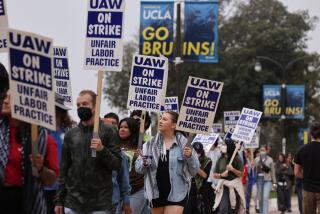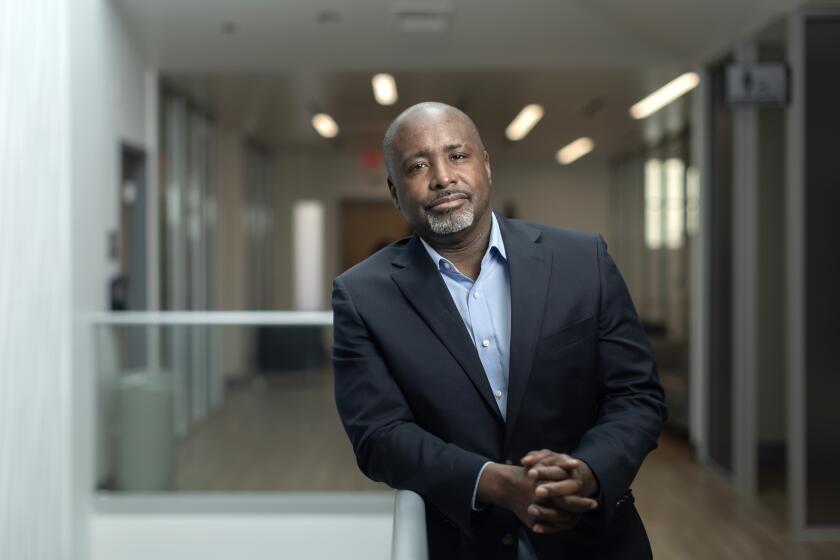It’s Bradley Vs. Yaroslavsky on Planning
Los Angeles Mayor Tom Bradley’s support for the formation of community planning boards as a way of dealing with the city’s growth sets the stage for his probable confrontation with Councilman Zev Yaroslavsky in the 1989 mayoral race.
Yaroslavsky, riding high after his successful Proposition U campaign restricting most commercial developments in the city to a 50,000-square-foot ceiling, attacked the mayor’s proposal, pushing instead his recently proposed “planning reform package” that would give the council a veto over every large-scale development in the city. Yaroslavsky is typically viewed in the planning community and in the minds of community activists as “slow-growth”; the mayor is perceived as “pro-growth.” But this time it is the Yaroslavsky proposal that would do the most damage to planning and politics in Los Angeles.
For the record:
12:00 a.m. April 5, 1987 For the Record
Los Angeles Times Sunday April 5, 1987 Home Edition Opinion Part 5 Page 5 Column 1 Op Ed Desk 1 inches; 24 words Type of Material: Correction
In an article by Dan Shapiro (Editorial Pages, April 1) the author was identified as president of the Studio City Residents’ Assn. He is a past president of that organization.
The contrast between approaches could not be more profound, and is in fact an argument over whether to substantially increase or decrease the council’s power. Yaroslavsky’s approach would substantially increase the power of the council and individual council members while the mayor’s approach would reduce it.
Bradley seeks to decentralize decision-making in the city by letting locally constituted neighborhood boards develop plans--in effect, community zoning ordinances--to govern development. Such an approach would reduce the ability of council members to control the destiny of their districts, and would disperse power into the community, which the planning process is supposed to serve.
The Yaroslavsky proposal would give the council the power of yes or no over every large project in the city. This would infinitely expand the council’s ability to do mischief in the planning process. Yaroslavsky calls for each project of 50,000 square feet or more to go through a conditional-use-permit process that requires the applicant to prove that the project is in the public interest. However, the public interest is simply defined by whether the developer can secure eight votes on the council in support of a project. Such an approach, which some have likened to a “lobbyists’ full-employment bill,” would assure a steady flow of campaign contributions into council coffers. As Yaroslavsky should know, individual members of the council have a diminished ability to control large projects in their districts. But when all of the council gets involved in the decision, a campaign-contribution feeding frenzy takes place.
As an example of the bankruptcy of the approach, one can use Yaroslavsky’s own failed attempt to enact a building moratorium in Westwood. The lobbying on that moratorium was intense. The rewards to the developers who successfully opposed it were in the hundreds of millions of dollars. The fact that the moratorium failed to secure the necessary eight votes should be a surprise to no one. Unfortunately, the council has too often shown a tendency to base decisions on checkbooks rather than on public-policy considerations. Yaroslavsky--who over the years has raised more than $1 million in campaign contributions, mainly from developers--knows that fact better than anyone on the council. The Yaroslavsky approach would auction every major project in the city to the highest bidder, and the public would lose in the end.
Instead of a completely discretionary approach to development, the city needs an agreed set of rules that can be followed by community members and developers alike. People who live in a community and who are affected by the planning decisions should have the right to participate in making those rules. That would be the role of the community planning boards. When variances from those agreed rules are requested, it is the members living in a community who should have the right to review the appropriateness of the request. Again, that would be the role of the community planning boards.
Once the rules are made, and updated community plans enacted, communities and developers alike should be willing to live with the results. However, a plan should not be static, and periodic reviews of its provisions also would be the role of the community planning boards.
True, some community leaders who have long fought large-scale development may eagerly be awaiting the day when every large project must go through a conditional-use-permit process. But they have only to look at their lack of success on the council to question whether in the end the Yaroslavsky proposals would only corrupt a system that is already perceived as having a minimum of integrity.
Bradley’s approach to the planning process, to ensure that members of a community will have a say over what is happening in their own neighborhoods, is far preferable to planning decisions being bought and sold on the floor of the City Council.
More to Read
Start your day right
Sign up for Essential California for news, features and recommendations from the L.A. Times and beyond in your inbox six days a week.
You may occasionally receive promotional content from the Los Angeles Times.






